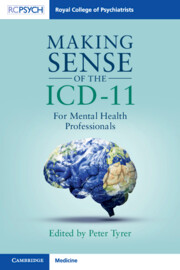Book contents
- Making Sense of the ICD-11
- Making Sense of the ICD-11
- Copyright page
- Contents
- Contributors
- Introduction
- Chapter 1 Development and Innovation in the ICD-11 Chapter on Mental, Behavioural and Neurodevelopmental Disorders
- Chapter 2 ICD-11 + DSM-5 = A Diagnostic Babel
- Chapter 3 Schizophrenia or Other Primary Psychotic Disorders
- Chapter 4 Mood Disorders
- Chapter 5 Disorders Specifically Associated with Stress
- Chapter 6 Disorders Due to Substance Use
- Chapter 7 Child and Adolescent Psychiatric Disorders
- Chapter 8 Anxiety and Fear-Related Disorders and Obsessive–Compulsive and Related Disorders
- Chapter 9 Personality Disorders
- Chapter 10 Disorders of Intellectual Development
- Chapter 11 Eating Disorders
- Chapter 12 Mental Health Classifications in Primary Care
- Index
- References
Chapter 6 - Disorders Due to Substance Use
Published online by Cambridge University Press: 13 October 2023
- Making Sense of the ICD-11
- Making Sense of the ICD-11
- Copyright page
- Contents
- Contributors
- Introduction
- Chapter 1 Development and Innovation in the ICD-11 Chapter on Mental, Behavioural and Neurodevelopmental Disorders
- Chapter 2 ICD-11 + DSM-5 = A Diagnostic Babel
- Chapter 3 Schizophrenia or Other Primary Psychotic Disorders
- Chapter 4 Mood Disorders
- Chapter 5 Disorders Specifically Associated with Stress
- Chapter 6 Disorders Due to Substance Use
- Chapter 7 Child and Adolescent Psychiatric Disorders
- Chapter 8 Anxiety and Fear-Related Disorders and Obsessive–Compulsive and Related Disorders
- Chapter 9 Personality Disorders
- Chapter 10 Disorders of Intellectual Development
- Chapter 11 Eating Disorders
- Chapter 12 Mental Health Classifications in Primary Care
- Index
- References
Summary
Disorders due to substance use include some of the major causes of morbidity and mortality worldwide. Alcohol accounts for 3 million deaths worldwide and 5.1% of the global burden of disease and is the leading cause of premature mortality and disability among people aged 15–49 years, accounting for 10% of all deaths in this age group.1 Tobacco, typically in the form of cigarettes, and with nicotine as the pharmacological addictive driver, is the cause of 8.7 million deaths and 7.9% of the global burden of disease.2 Among the 25- to 49-year-old age group, psychoactive drug use causes 2.9% of the global burden of disease,3 deaths having increased by 70% over the past decade, and opioids accounting for 70% of them.4 Prescribed opioids and sedative-hypnotics also claim significant morbidity and mortality.
- Type
- Chapter
- Information
- Making Sense of the ICD-11For Mental Health Professionals, pp. 70 - 85Publisher: Cambridge University PressPrint publication year: 2023



